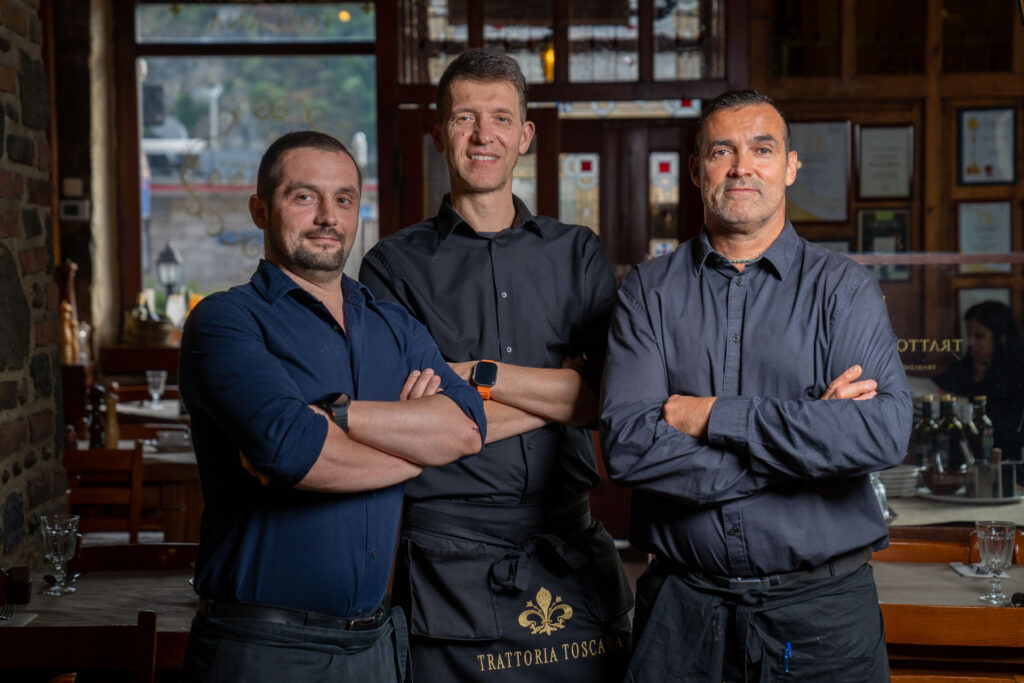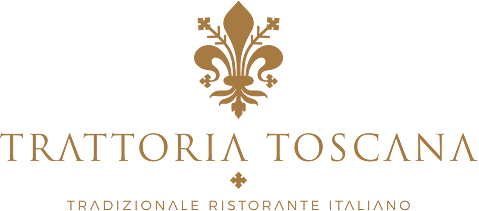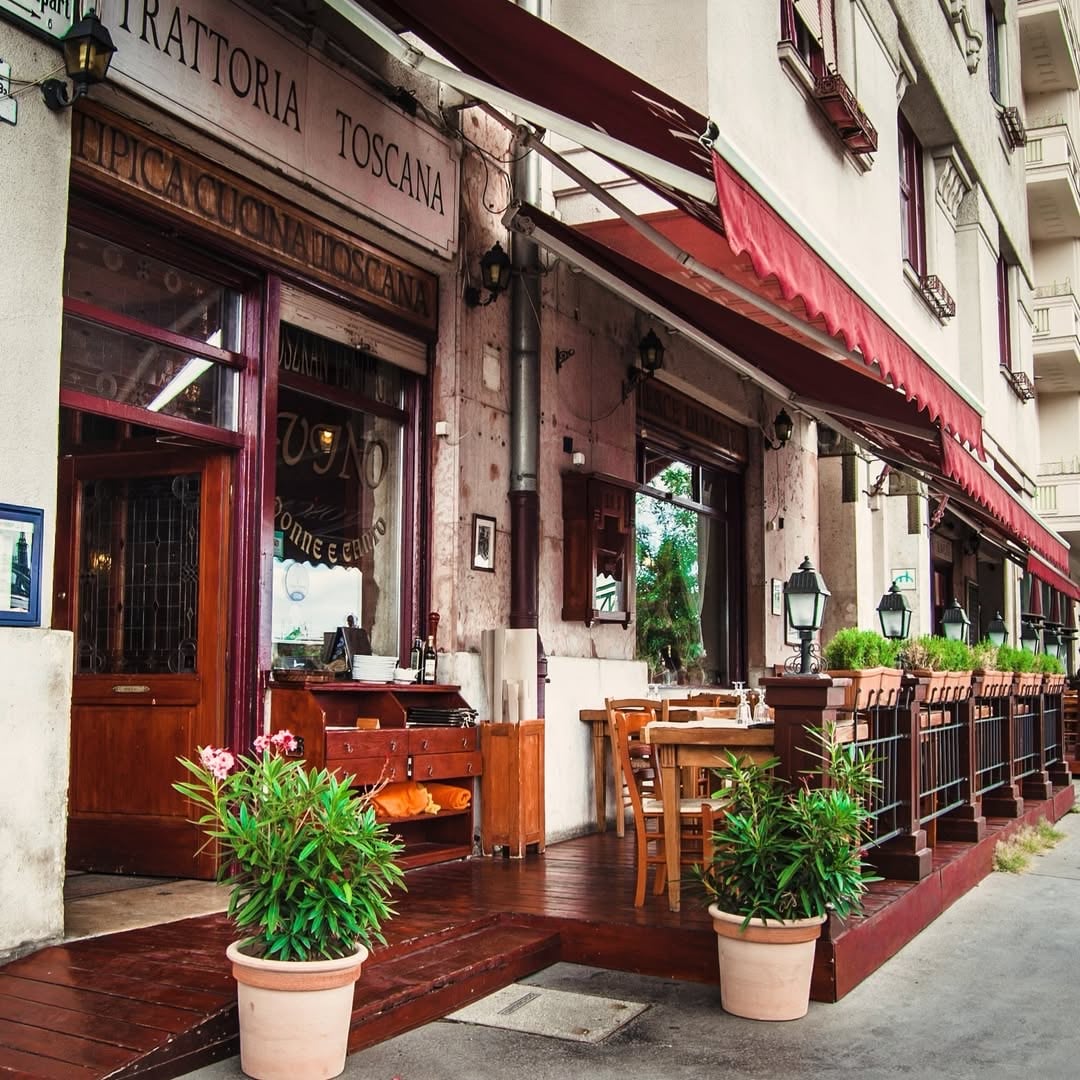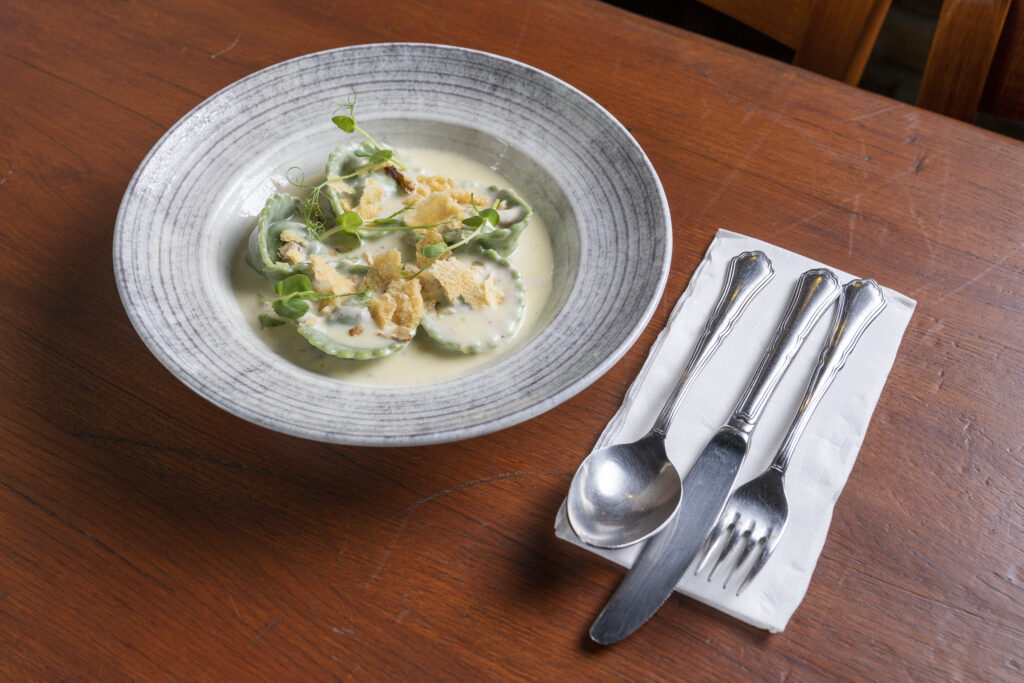
Italian cuisine is legendary all over the world, and so is the experience of Italian dining: the true joy is found not only in the flavors, but in everything that makes us love the Tuscan lifestyle itself. It’s about the moments around the table, living traditions, gestures, the elegant Italian simplicity, and the lively conversations enjoyed over a good glass of red wine. Now, let us guide you into the stylish and exciting world of Italian etiquette!
You can already greet people at the entrance: “Buongiorno!”
Italian restaurant etiquette places great importance on social interaction and the idea that dining takes place in a communal setting: upon arrival, it is proper to greet everyone in the restaurant with a smile and a friendly “Buongiorno!” or “Buonasera!” As you step through the door, you become part of the community inside; you wait to be shown to your table, as choosing the table is almost a ritual from this point on. And here at Trattoria Toscana, you can be sure that a warm, welcoming, and elegant atmosphere always awaits our guests.
The rhythm of Italian dining: What, when, and how is food served?
Italians believe that the sweetest moments are always created around the table! That’s why mealtimes are almost ritualistic—whether it’s lunch or dinner, the structure of the meal is carefully composed, with courses rich in details and flavors. There are usually several courses, and each one receives the same careful attention—yes, even here in our restaurant.
It’s important to know that Italians rarely add sweetness to their main dishes — the salty, savory flavors always come first. Dessert only comes afterward, and even then, they don’t rush it. They enjoy it slowly, calmly, and with time to spare.
The elements of the meal:
- Antipasti – refers to light appetizers, such as a slice of crostini or a few bites of fresh mozzarella, which can be excellent choices.
- Primo piatto – this course is usually pasta, risotto, or soup. It might be surprising, but in Italy, salad is often not served as an appetizer—instead, it typically comes after the main course.
- Secondo piatto – meat or fish, often accompanied by a side dish (contorno), though these are served separately. Unlike in Hungarian cuisine, the plate is never crowded—each course has its own dedicated space!
- Dolce – dessert comes next, followed by coffee, which is served strictly short, black, and strong.
We should also mention the pane-t, that is, the bread, a constant presence, primarily so you can enjoy every last drop of sauce (“fare la scarpetta”—perhaps the most charming Italian table custom, where you use a piece of bread to wipe your plate clean), and wine is always on the table, paired appropriately with each course.
It’s important to note that meals traditionally last a long time, with leisurely conversations; at the big Sunday family lunch, no one is in a rush to leave. For Italians, mealtime is a sacred occasion being invited is considered the highest expression of love and affection.
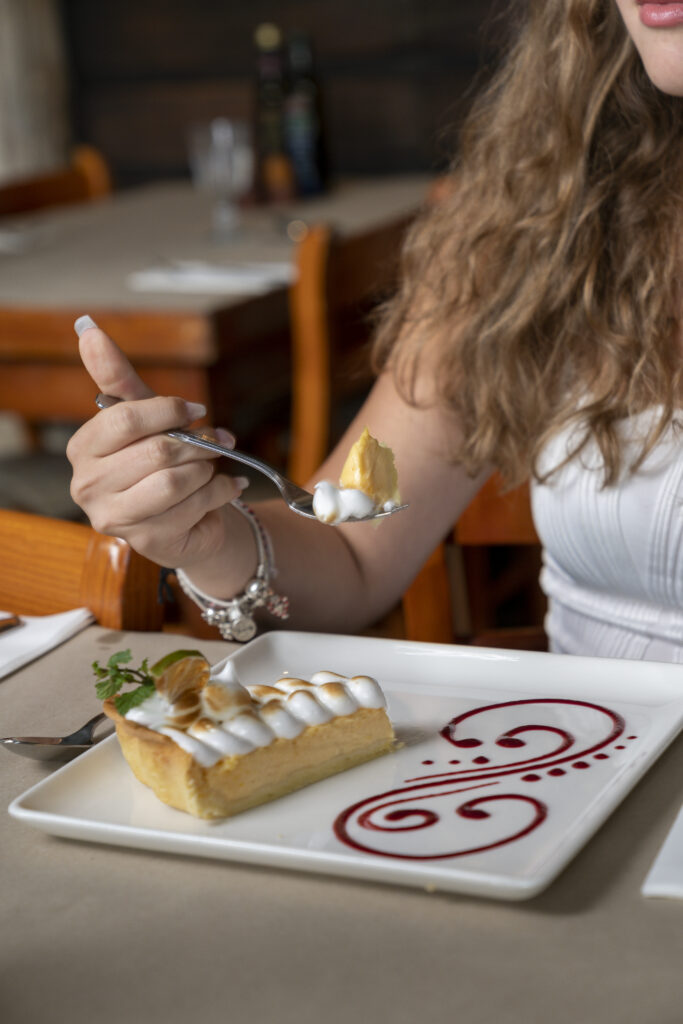
The subtleties of table etiquette
Italian etiquette is like a well-composed song: it has recurring themes and rules, but there’s always room for a bit of improvisation! But what’s considered polite—and what isn’t?
Using utensils: Italians are masters at using a knife and fork, enjoying meat, salad, and other dishes with their utensils rather than their hands.
Separating the courses: they never pile everything onto one plate each dish, each course deserves its own recognition and respect.
Tasting the bread: bread is a constant presence on the table, as it’s the perfect tool for mopping up the last bit of sauce—“la scarpetta” is pure enjoyment. However, Italians never bite directly into the bread; instead, they always break off small pieces by hand.
The simple pleasures of wine drinking: everyone at the table always drinks wine from a glass, never straight from the bottle, and the glass is never filled to the brim they leave room for the wine to “breathe.”
Let’s offer to share with our friends! Whatever is on the table bread, cheese, or a bite of appetizer we should offer it to others, even if we know they can easily reach it themselves.
Wine, coffee, digestivo, where milky coffee is a no-go
Wine, coffee, and digestivo traditions are an essential part of Italian table etiquette.
At Italian dinners as with Sunday lunches, as mentioned there is always wine on the table: red wine (vino rosso) is served with meat, while white wine (vino bianco) is paired with fish.
After dinner — which is typically enjoyed between 8 and 10 PM — it’s traditional to have a digestivo, an alcoholic drink meant to aid digestion, such as limoncello or grappa.
Coffee drinking is a true ritual: in the morning, a quickly sipped cappuccino is the norm, but after dinner, only espresso is enjoyed. And it’s important to note: Italians would never order a milky coffee after lunch or dinner.
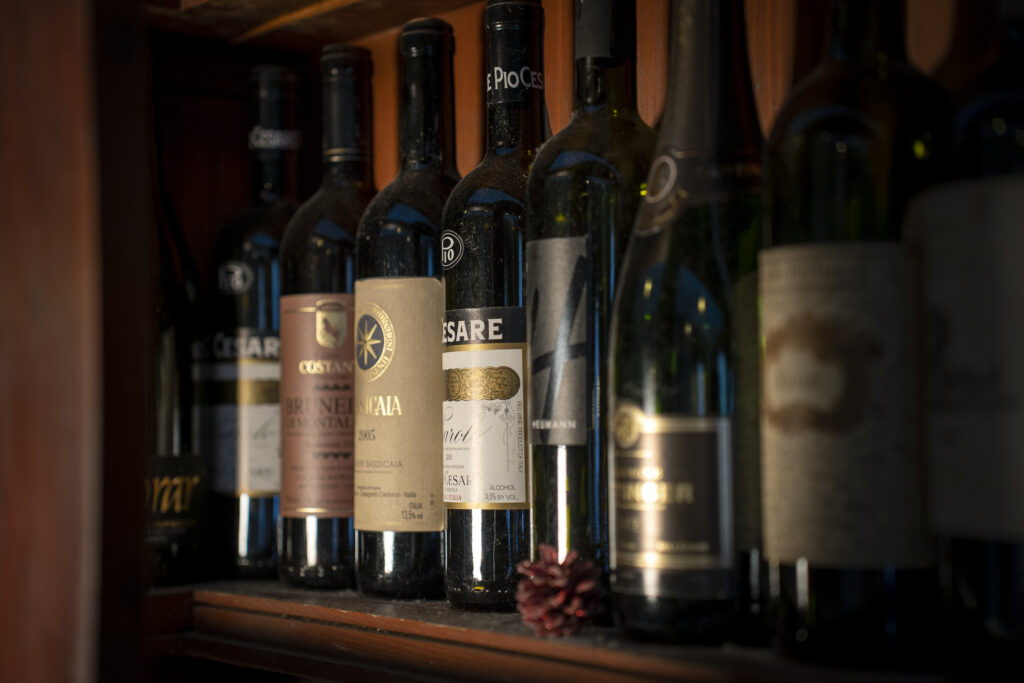
Being invited to dinner, and the etiquette of punctuality and lateness
In Italian culture, it’s common to greet a table of people even if you don’t know anyone—often simply because you’re passing by and because a cheerful “Buongiorno!” or “Buonasera!” is always appreciated. In return, “Arrivederci!” signals the hope of meeting again. Using words like “prego” (please/you’re welcome), “grazie” (thank you), and “prego” (you’re welcome) is a thoughtful and expressive gesture.
If you’re invited to someone’s home, it’s customary to bring a bottle of wine or some kind of treat as a gift. Arriving exactly on time isn’t expected—in fact, being 10 to 15 minutes late is perfectly acceptable, since Italians don’t like to rush. At the table, conversation is at least as important as the food itself: everyone shares their joys and stories—there’s no room for silence!
Dress code, personal space, and volume at the table
For Italians, the way you dress and present yourself is a sign of respect and a zest for life. Whether it’s a family lunch, a dinner with friends, or an elegant restaurant outing, Italians always make sure to show up in a refined yet relaxed style.
A few rules of Italian elegance in restaurants:
- Formal evening wear or a suit is not requiredbut a neat and well-groomed appearance is a must. An elegant dress, a pressed shirt, and clean, simple colors work perfectly. The focus is on harmony and subtly highlighting your personality.
- Especially for dinner, as well as family or social gatherings it’s appropriate to wear at least smart, well-put-together casual clothing to show up.
- It’s best to use only a little perfume – at the table, the scents should come from freshly baked bread, olive oil, or basil—not from artificial fragrances!
And what about personal space? Italians are warm and friendly, and small gestures like a pat on the shoulder are common. Still, they respect each other’s personal space.
In restaurants and at the table—especially when seated in a room with strangers—a polite, “intimate” distance is always maintained. No one crowds the person next to them, speaks loudly, or leans in too closely. In conversation, care is taken thatthe comfort of fellow diners is never disturbed by loud voices or sudden movements. – Italian etiquette is all about making every guest feel they have enough space, time, and attention. For Italians, the table is a place where everyone is equally important and treated as an equal. Even “bambini” (children) learn from an early age that at the table, everyone is a “little Italian” of their own—both in how they dress and how they behave.

Other important things to know about shared dining etiquette
1. Wait for everyone before you start eating!
According to Italian etiquette, you should wait until everyone has food in front of them at the table, and someone—usually the host—starts the meal by wishing everyone “Buon appetito!” (Enjoy your meal!). It’s never polite to begin eating before the others.
2. No cell phones allowed
In a tradition-minded country like Italy, it’s considered especially rude to put your phone on the table or use it during dinner. True social life is all about being present and enjoying the conversation!
3. Serving etiquette – who should be served food and drinks first?
According to Italian etiquette, women and guests are served food and drinks first, followed by the men, and finally the host.
4. Volume and conversation
While Italian families can sometimes be lively and loud, in a restaurant setting, polite conversation, a moderate speaking volume, and respect for others’ privacy are essential.
5. Service charge and tipping
The “coperto” (cover charge) is often automatically included on the bill in Italy. Tip only if you’re especially satisfied—5-10% is enough, but never the full amount!
6. Napkin, glass, utensils – order of use:
The napkin should always be placed on your lap, never tucked into your collar. Clinking glasses loudly is only for family gatherings—at more formal occasions, toasting is more reserved. Utensils are used from the outside in, according to each course.
7. Toast and raising a glass:
Before official or festive meals, it’s traditional to have a communal toast (“Salute!”, “Cin cin!”). After the toast, it’s customary to take a small sip, not to down your drink in one go.
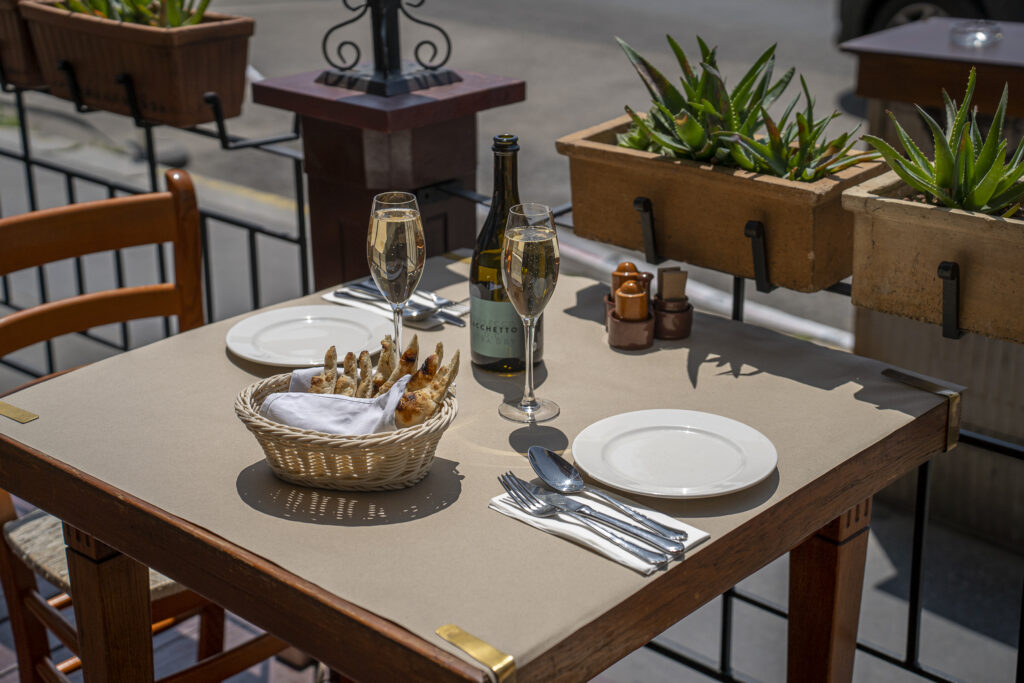
Our summary tips for avoiding faux pas
- Never add cheese to seafood dishes—that’s considered a serious faux pas!
- Don’t order a cappuccino after dinner—it’s only for breakfast! Italians never drink milk with their evening meals.
- Don’t eat dinner too early, and don’t rush! Mealtime is meant to be savored take your time and enjoy every moment at the table.
- Never overcrowd your plate, and take your time with every bite. Italian cuisine is also about moderation.
- Spaghetti is served in a deep plate, and you should never cut it! Instead, twist the pasta around your fork.
- It’s not proper to eat bread together with pasta.
- Parmesan cheese is generally not requested with fish or seafood dishes, so be mindful of this tradition.
- It’s considered impolite to slurp big spoonfuls of soup, and you shouldn’t put the entire spoon into your mouth—instead, soup is eaten gently, in small sips.
Despite all this, Italian etiquette is far from a rigid system; it’s more of a lifestyle, where every gesture and action is made in the spirit of enjoyment and spending time together.
If you want to experience the magic of the Italian table and savor the passion of fresh tomatoes, homemade pasta, and Tuscan wines, we look forward to welcoming you at Trattoria Toscana! Here—while we honor Italian etiquette—we won’t judge if you dig into your soup with a big spoon or cut your spaghetti.
Book a tableif you’d like, give Italian etiquette a try and become a little Italian yourself… at least at dinnertime! Buon appetito from all of us at Trattoria Toscana!
The Italian way of life in Budapest: Your invitation to Trattoria Toscana
